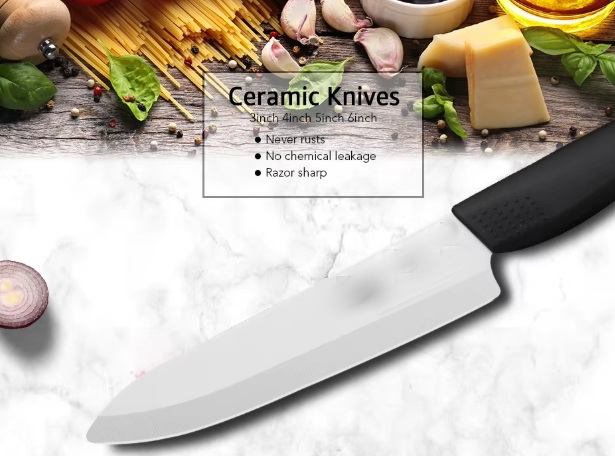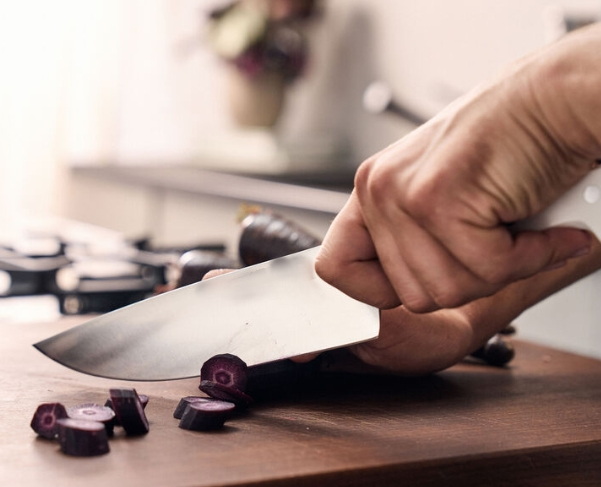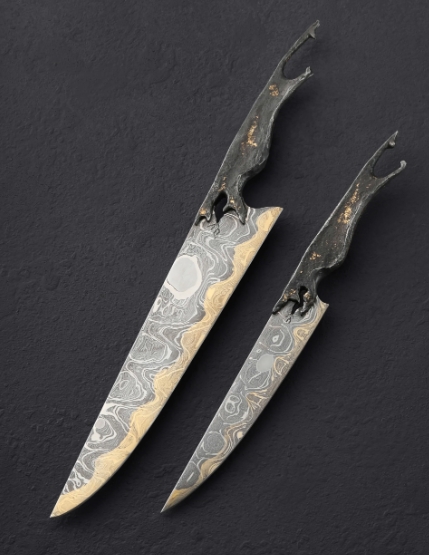

Views: 222 Author: Ella Publish Time: 2025-05-05 Origin: Site








Content Menu
● Understanding Knife Edges: Types and Characteristics
>> V Edge
>> Convex Edge
>> Hollow Edge
>> Chisel Edge
● Sharpening Angles: Finding the Perfect Balance
>> The Impact of Angle on Edge Performance
● Blade Grind Types and Their Impact on Edges
>> Flat Grind
>> Convex Grind
>> Hollow Grind
>> Scandi Grind
● Western vs. Japanese Chef Knife Edges
● Maintenance Tips for Chef Knife Edges
>> Sharpening
● FAQ
>> 1. What is the ideal sharpening angle for a chef knife?
>> 2. How does steel hardness affect the edge angle?
>> 3. What is the difference between a V edge and a convex edge?
>> 4. Should I sharpen my chef knife at home or take it to a professional?
>> 5. How often should I sharpen and hone my chef knife?
Choosing the right edge for a chef knife is crucial for both performance and durability in the kitchen. The edge type influences how sharp the knife is, how long it stays sharp, and how well it handles different cutting tasks. This comprehensive guide explores the various types of edges, sharpening angles, blade grinds, and maintenance tips to help you find the best edge for your chef knife.

The V edge is the most common edge type for kitchen knives. It features two flat surfaces that meet at a sharp point, forming a "V" shape in cross-section. This edge is relatively easy to sharpen and offers a good balance between sharpness and durability. It tends to last longer than finer edges and is versatile for most kitchen tasks, such as slicing vegetables, dicing onions, or cutting meat. Because of its symmetrical shape, the V edge is also easier to maintain for beginners and professionals alike.
A convex edge has curved surfaces that meet at the cutting edge, resembling a bullet shape in cross-section. This design is stronger than a V edge while maintaining sharpness. It is more challenging to sharpen but provides excellent edge retention and durability, making it ideal for heavy-duty kitchen work. The convex edge's rounded bevels reduce the risk of chipping and rolling, which is especially beneficial when cutting through tougher ingredients like squash, root vegetables, or even small bones. This edge type is favored by many professional chefs who require a robust, long-lasting blade.
The compound bevel edge combines a primary bevel with a smaller secondary bevel near the tip. This design protects the edge from rolling or chipping, enhancing both sharpness and durability. Sometimes, the secondary bevel is convex, creating a hybrid shape that balances cutting performance and edge strength. The compound bevel is often found on Western-style knives designed for versatility, allowing chefs to perform delicate slicing and heavy chopping with the same tool.
The hollow edge features concave sides that create a very thin and sharp edge. While extremely sharp, this edge is more prone to damage and is less common in chef knives. It is often found in hunting or outdoor knives where slicing precision is prioritized over durability. In the kitchen, hollow edges are sometimes used on specialty knives like slicers or fillet knives, where thin, precise cuts are necessary, but the edge is not subjected to heavy chopping.
A chisel edge is sharpened on only one side, creating an asymmetrical blade. It is common in Japanese knives and excels at precise, delicate cuts. However, it requires more skill to maintain and is less versatile for general kitchen use. The chisel edge allows for incredibly sharp cuts, ideal for sushi chefs or those who need extreme precision. However, because the blade is beveled on one side only, it can create a slight curve in the cut, which may not be desirable for all cooking styles.
The sharpening angle significantly affects the knife's sharpness and edge retention. The angle is the tilt at which the blade meets the sharpening surface, and it is measured per side of the blade.
- 15° to 16° per side: Typical for Japanese knives with very hard steel. This angle produces an extremely sharp edge ideal for delicate slicing but is more prone to chipping.
- 18° to 20° per side: The most common angle range for Western-style chef knives. It balances sharpness and durability, suitable for a wide range of kitchen tasks.
- 22° to 25° per side: Used for knives that require extra durability, such as those used for chopping through tougher ingredients or bones.
- For precision slicing and softer ingredients like vegetables, fish, and boneless meats, a lower angle (15°–18°) is preferable for a sharper edge that glides through food effortlessly.
- For heavy-duty chopping and tougher materials such as thick-skinned squash, dense root vegetables, or meats with bones, a higher angle (20°–25°) provides a more durable edge that resists chipping and rolling.
- The steel hardness influences the ideal angle: harder steels can maintain sharper, lower angles, while softer steels benefit from higher angles to prevent edge deformation.
A sharper edge with a lower angle cuts more cleanly and requires less force, reducing fatigue during food preparation. However, such edges are more delicate and require more frequent maintenance. Conversely, a higher angle edge sacrifices some sharpness for toughness, making it more forgiving in a busy kitchen where knives may encounter harder materials or accidental impacts.

The grind of the blade refers to how the metal behind the edge is shaped, affecting cutting performance and edge strength.
The blade tapers in a straight line from spine to edge. It offers a good balance of sharpness and durability and is common in many chef knives. Flat grinds are easier to sharpen and maintain, making them popular among home cooks and professionals.
The blade curves smoothly toward the edge, creating a stronger and more durable edge that resists chipping. It is favored for knives that need to withstand heavy use. The convex grind reduces drag when slicing and allows the knife to cut through tougher materials with less effort. However, sharpening a convex grind requires skill and specialized tools.
The blade is concave behind the edge, producing a very thin and sharp edge but with less durability. It is less common in chef knives but useful for specialized tasks such as filleting fish or delicate slicing. The hollow grind allows the knife to slice cleanly with minimal resistance but can dull quickly under heavy use.
The blade has a single bevel that meets at the edge, commonly used in outdoor knives but less so in kitchen knives. It is easy to sharpen and maintain but not ideal for all kitchen tasks due to its specific cutting characteristics.
| Feature | Western Chef Knives | Japanese Chef Knives |
|---|---|---|
| Edge Angle | Typically 20° per side | Typically 15° per side |
| Steel Hardness | Softer, more durable | Harder, sharper but more brittle |
| Edge Type | Usually V edge or compound bevel | Often single bevel or very acute V |
| Blade Thickness | Thicker, heavier | Thinner, lighter |
| Edge Retention | Moderate, easier to sharpen | Longer-lasting but requires care |
Japanese knives favor sharper, thinner edges for precision, while Western knives prioritize durability and ease of maintenance. This difference is reflected in the edge types and sharpening angles used by manufacturers and chefs.
Maintaining the edge of your chef knife is essential for optimal performance and safety. Proper care extends the life of the blade and ensures consistent cutting quality.
Honing realigns the microscopic teeth of the blade edge without removing metal. Using a honing rod before or after each use keeps the edge straight and sharp. Honing is quick and easy, preventing the need for frequent sharpening.
Sharpening removes metal to restore the blade's edge. Use whetstones, diamond stones, or quality sharpeners at the correct angle to maintain the edge. Sharpening frequency depends on usage but is generally needed every few months or when honing no longer improves sharpness.
Dishwashers expose knives to harsh detergents and high heat, which can corrode the blade and damage the edge. Always hand wash your knives with mild soap and dry them immediately.
Store knives in a knife block, on a magnetic strip, or in blade guards to protect the edge from dulling. Avoid keeping knives loose in drawers where they can bump against other utensils.
Use cutting boards made of wood or plastic. Hard surfaces like glass, ceramic, or stone can dull the edge quickly.
The best edge for a chef knife depends on your cooking style, the types of ingredients you handle, and how much maintenance you are willing to perform. A V edge at around 20 degrees per side is an excellent all-around choice for most home cooks, offering a balance of sharpness and durability. For those seeking precision and willing to care for their knives carefully, a sharper 15-degree edge with a convex grind can provide superior cutting performance. Conversely, if your kitchen tasks involve heavy chopping, a higher angle edge with a robust grind will extend edge life and prevent damage.
Understanding the trade-offs between edge types, angles, and blade grinds will empower you to select and maintain the perfect edge for your chef knife, enhancing both your cooking experience and safety.

The ideal angle is usually between 15 and 20 degrees per side. Lower angles produce sharper edges but are more delicate, while higher angles offer greater durability.
Harder steel can hold a sharper, thinner edge at lower angles without chipping, whereas softer steel benefits from higher angles to avoid edge deformation.
A V edge has flat bevels meeting at the edge, easy to sharpen and versatile. A convex edge has curved bevels, stronger and more durable but harder to maintain.
You can sharpen at home with proper tools and knowledge, especially using whetstones. However, professional sharpening ensures precision and is recommended if you are inexperienced.
Honing should be done regularly to maintain the edge alignment, often before or after each use. Sharpening frequency depends on usage but typically every few months or when the knife no longer hones well.